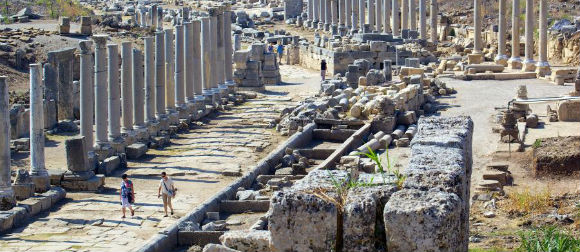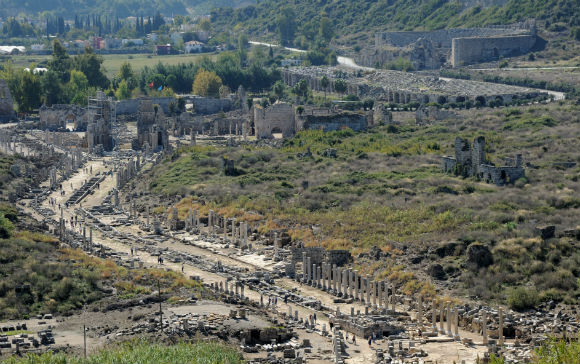The most impressive ruins of the Pamphylian coast are at Perge, at about 15 km east of Antalya. Perge was originally founded by the Hittites around 1500 BC. and was known as Parha. It was a successful trading centre near the Aksu (ancient Kestros or Cestrus) river when Alexander the Great arrived in 333 BC. He was welcomed in by the inhabitants and used Perge as base for his Anatolian campaigns. Alexander was followed by the Seleucids under whom the city prospered and Perge’s most celebrated inhabitant, the mathematician Apollonius from Perge lived and worked. Apollonius was a pupil of Archimedes and wrote a series of eight books on geometry. In 188 BC Perge became part of the Roman Empire during which the city flourished. Most of the surviving buildings date from this period.In 46 AD St. Paul started his journey in Perge (biblical Perga) and preached his first sermon here. Perge gradually declined during the Byzantine period, as the Aksu river silted, but remained inhabited until Selçuk times after which it became abandoned.
A visit to Perge starts by entering the archeological site through the Roman Gate, built during the reign of Septimius Severus (193-211 AD). Proceeding through the gate, to the right is the Agora or market place. This structure of 75 x 75 m dates back from the 2nd century AD. The center courtyard and shops were surrounded by a wide stoa, a covered walkway. The floor of the stoa and shops was made of colored mosaics. The agora was not only the centre of Perge’s trade, but was also a place for meetings as well as a forum for political, social, and philosophical discussions. The next building is the Hellenistic city gate that dates back to the 3rd century BC. This is certainly the most imposing building of the city and was cleverly designed to protect the city with its twin towers and its horseshoe-shaped courtyard at the back. It is thought that the towers had three floors and were crowned by a conical roof. In the year 121 AD, the horseshoe-shaped courtyard was rededesigned as a courtyard of honor. Behind the courtyard stood a triple arch. Around the arch there are about dozen inscriptions connected with Plancia Magna who lived in the 2nd century AD. She was the daughter of the governor, a priestess of Artemis Pergaia (Diana) and a benefactress to the city. Plancia Magna had the arch decorated with the statues of the emperors and their relatives.
After passing through the Hellenistic Gate and courtyard, one enters a broad, marble-paved double-colonnaded street measuring 300 meters in length that extends from the main gate to the acropolis. The street is 20 m wide and is divided in two by a 2 meter wide water channel running down the middle. At the end of the colonnaded street is the Nymphaeum, a triumphal fountain from where a stream flowed down into the water channel. The nymphaeum or nymphaion is an ornamental semicircular structure and dates from the reign of Emperor Hadrian (130-150 AD). A statue of a river god Kestros was located in the center of this huge fountain. Behind the nymphaeum is the acropolis with some remains of the Byzantine period. To the west of the nymphaeum are the remains of a palaestra dating from 50 AD and dedicated to the Emperor Cladius (41-54 AD).
Returning back to the entrance, there are the excavated Roman baths located southwest to the agora. Out of the site proper, is the horsehsoe-shaped stadium, the largest in Asia Minor, measuring 234 m by 34 m. The stadium had a seating capacity of 12,000 people supported by massive barrel-vaulted constructions. Just beyond the site entrance is also the theatre, which is of the Greco-Roman type and could seat 15,000 people. Unfortunately, it is for some time under reconstruction and unfortunately closed to visitors.
Perge,



I think Perge is a must-see if you are at Turkey. But be warned – the weather can be killing if you go in summer like what I did. But I should not complain because the pictures taken on such days are beautiful.
A must-see for people that love history and appreciate ancient ruins.
My only complaint was the travel…
I was told this site was in one of the best conditions, and it was. It was hard to believe how old this places is. Lots of building parts are laid out to continue the restoration work, and there was digging still going on at the end furthest away from the entrance gate. The rows of well-preserved columns cannot fail…
It is quite easy to imagine how life was lived in this city. The collanaded street with centre water feature and the Agora with its surrounding shops were interesting. Sites were well explained.
We enjoyed this site. In my opinion you really need a guide to explain what is here to get the best of this ruined city, otherwise you don't notice or understand the best bits.
To add a little to the practical information provided by “A TripAdvisor Member” on 12 May 2005.
If you don't fancy a dolmus, the buses to Aksu leave from the stop directly opposite the PTT (post office) on the south side of Aspendos Bulvari, just to the east of the big roundabout known as Meydan. If you pick up one…
if you enjoying amazing architual remains of a roman city then vist Perge a wonderfull example be sure to take a hat and water it did get very hot hardley any shade about
we visited Perge in July 2010. It's an ancient city with columns, amphitheater, old city squares, streets.
we really liked it and advise to visit Perge to tourists who visit Turkey
Perge is one of the largest area of ancient ruins in Antalya and a must visit if you're interested in Roman architecture/urban planning. Standing on the main street in the ancient city is impressive – you can just imagine the shops, public area, and people still bustling with activity. To get the most out of the experience, I recommend a…
One of the best – if not THE best – preserved Roman stadiums in the world. The Agora (marketplace) is fascinating, and the Roman baths should not be missed. Highly recommended!
we love anything about Rome ruins, Perge Antalya is a must to see, the site is well preserved and some undergoing excavation on the site.
We spent 2 hours just admire how magnificent this site is, we just did not want to leave.
Wonderful !